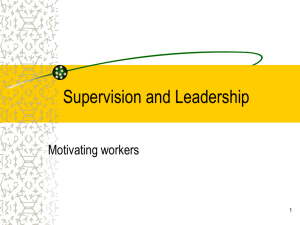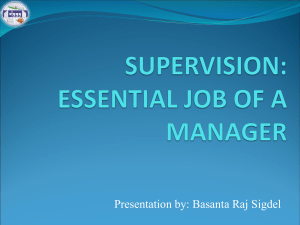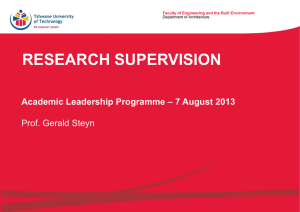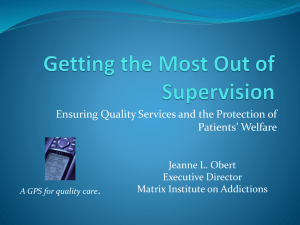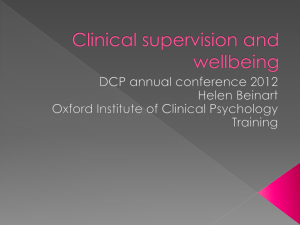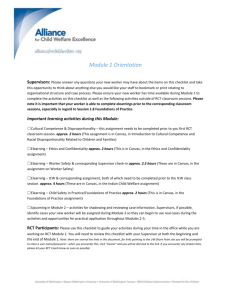Supervision and Management - Social Work Policy Institute
advertisement
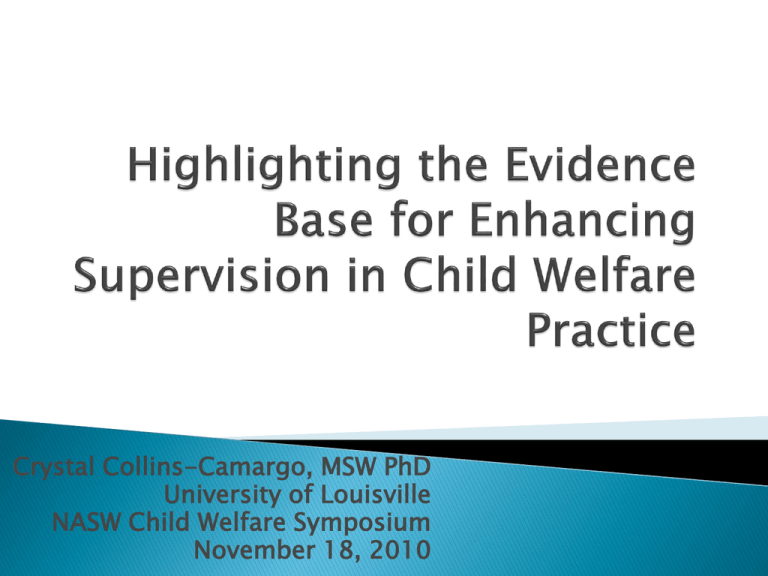
Crystal Collins-Camargo, MSW PhD University of Louisville NASW Child Welfare Symposium November 18, 2010 Past research links supervision to: Reduced Worker Burnout/ Stress (e.g., Martin & Schinke, 1998; Ratfill, 1988;) Turnover/Retention (e.g. Yankeelov, Barbee, Sullivan, & Antle, 2009; Strand & Dore, 2009; Jacquet et al., 2007; Landsman, 2001; Ellett & Millar, 2001) Perceptions of Organizational Culture (e.g. Collins-Camargo & Royse, 2010; Cohen & Austin, 1994) Managing boundaries, approaches to families (Banach, 1999) Motivation & service intensity (McGrew and Bond, 1997) Ability to assess and treat families (Young, 1994) Analytic skills (Berkman & Press, 1993) Successful risk assessment in child protection (DePanfilis, 1996) CA/N fatalities (Nash,1997) Client engagement (Bibis, 1993) Client satisfaction (Harkness & Hensley, 1991) Client contentment and goal attainment (Harkness, 1995) CW self-efficacy and client outcomes (Collins-Camargo & Royse, 2010) Conceptual Model Regarding the Mechanism for Supervisory Influence Organizational Change Organizational Culture Supervisor Workers Effective Performance Worker Retention Comprehensive review of the literature Working group of child welfare administrators, supervisors, and others interested in supervision Structured key informant interviews with practitioners, supervisors and administrators, experts in child welfare supervision and members of the NRCOI Peer Training Network Recruit, select, train (or arrange for training), and retain staff Identify/manage/evaluate caseworker performance Facilitate communication and collaboration Build and maintain working relationships with other units in agency Manage caseloads Manage time and workflow for supervisor Monitor caseworker responsibilities to supervisor Provide leadership to unit Provide leadership within organization Provide leadership within community Anticipate/address/manage change within unit Interpret and influence the organizational culture within the unit Manage time and workflow for caseworkers Influence agency Anticipate/address/manage change within agency Use management information systems (MIS) Educational Supervision Case staffing/case reviews Address ethics in caseworker practice Address ethics in supervision Provide ongoing professional development for supervisor Develop/monitor caseworkers’ family-centered practice competence Promote caseworkers' selfreflective practice, critical thinking and case decisionmaking Develop/monitor caseworkers’ cultural competence Provide ongoing professional development for caseworkers Promote evidence-informed practice Assist caseworkers in applying learning from training, workshops, etc. Supportive supervision Prevent/address stress/secondary traumatic stress/burnout for supervisor Anticipate/manage risk (safety) Prevent/address stress/secondary traumatic stress/burnout for caseworker Enhance caseworkers’ job satisfaction/build and maintain morale 2002 Child Welfare Supervision Study Across Six States: What should be the primary responsibility of supervisors? (N=836) Primary Responsibility of Supervisors Most important: Supporting the work of line workers 4% 3% Monitoring Practice 6% 7% Policy compliance 45% 10% Making casework decisions Other 25% Training Administration •on-the-job training •modeling good practice •case consultation •case decisionmaking •on-going feedback •policy clarification •worker safety Arkansas Mississippi Missouri Tennessee Study Sites Effectiveness of Supervision and Organizational Culture (2 States) Intent to remain employed/turnover (2 states) Self-efficacy in child welfare tasks (3 states) Trends in case outcomes (2 states) Supervisor practice, worker practice and client outcomes based on qualitative data (4 states) Favorable Cross-site Findings Quality Improvement Center on the Privatization of Child Welfare Services survey of frontline staff and supervisors in public and private agency settings Examples of some relevant findings (n >900) These preliminary, interim data are shared as examples of how supervisors can influence evidence-informed practice only and are not reflective of data regarding project outcomes Frequency of Team Discussion in Terms of What the Activity Might Mean for Work with Clients (1 Never; 3 Sometimes; 5 Very Often) FREQUENCY Topics discussed State 1 State 2 State 3 Quality assurance reports Reports on the team’s meeting practice standards Reports on the team’s performance in meeting client outcomes Peer Record Reviews Local performance information/ tables giving data for all teams State performance information/ tables giving data for all teams Research on what improves outcomes for children and/or families How we should work with children and/or families in order to achieve identified outcomes 3.71 3.58 4.00 4.06 4.01 4.50 3.75 3.96 4.33 2.96 3.64 3.83 3.58 3.28 3.17 3.17 3.07 3.00 3.00 3.33 3.00 3.46 3.95 4.17 State 1 State 2 State 3 Do you use data evidence or reports to guide your worker’s practice? Do you use research findings to guide your worker’s practice? 81.8% 72.7% 90% 72.7% 36.4 63.3% Do you role play or model client scenarios to guide your worker’s practice? 45.5% 77.3% 70% Does your supervision session include a clear set of expectations and objectives to guide your worker’s practice? 81.8% 90.0% 90% Do you feel comfortable challenging current practice with research based ideas? 63.6% 81.8% 83.3% Questions State 1 State 2 State 3 Is supervision an opportunity to reflect on your practice, and how it is impacting clients? To what extent do conversations with your supervisor contribute to better outcomes for children/youth/families? How often do you and your supervisor discuss what success might look like (i.e. measurable outcomes for children) 3.17 2.82 2.99 4 3.82 4.03 3.77 3.54 3.75 How often do you and your supervisor discuss which of the alternative courses of action is likely to be more effective, and how you will know if it is? 3.52 3.49 3.57 How often do you and your supervisor discuss what your team’s performance data tells you that may help you improve your practice with clients? 3.81 3.49 3.3 Questions It’s about learning ◦ A supportive learning organizational culture ◦ Having a relationship with staff that makes looking at evidence and adjusting practice safe It’s about modeling ◦ Using evidence regarding Readiness for EIP Staff perceptions re: outcomes orientation Staff assessment of what is happening on team and in supervision It’s about relationship It’s about vision ◦ Keeping the team’s eye on the prize Safety Permanency Well-being A sustainable workforce An organizational culture that is based on learning and evidenceinformed practice Practice enhancement Improved outcomes for children and families
